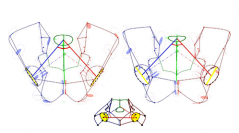

 Comptes Rendus Palevol
5 (3-4) - Pages 583-595
Comptes Rendus Palevol
5 (3-4) - Pages 583-595We analysed 51 adult pelvises (25 women, 26 men) by the software DE-VISU, conceived by one of us, J. Hecquet. It allows the description of the pelvis as the keystone of the articular system linking vertebral column, pelvis and lower limbs. The variations of the sagittal pelvic parameter, ‘angle of incidence’ (mean 54°), allow us to predict individual variation in sagittal spine curves. The extreme values of incidence (32°–76°) correspond to pathological situations. This angle was discovered by radiological observations. We elucidated the morphological components of this angle: a high angle of incidence, associated with a strong lumbar curvature, is correlated to a strong sacral slope, a curved sacrum, a low position of the sacrum in relation to iliac crests. A low angle of incidence, associated with a weak lumbar curvature, is correlated to a weak sacral slope, a rectilinear sacrum, a high sacral position in relation to iliac crests. The performances of the software DE-VISU gave results far superior to those we obtained by geometric morphometry. It benefits from previous studies and publications of the authors on rachis, pelvis and lower limb. Ability to represent each pelvic joint, particularly the two coxo-femoral joints, was crucial. Calculation of centres, radii, directional axes and covering arches of the acetabula allowed us to quantify the parameters of their three-dimensional orientation. We put in light for the first time these parameters. The angles of acetabular anteversion, inclination and covering arch revealed their high variations. These parameters establish the relationship between pelvis and mechanical axes of lower limbs through the femoral angles: angle of anteversion of the femoral neck, cervico-diaphyseal angle and bicondylar angle. DE-VISU introduced for the first time a ‘systemic analysis’ of the pelvis: it is no longer considered as an isolated object but as a piece of an integrated articular system.
Pelvis, Acetabula, Vertebral column